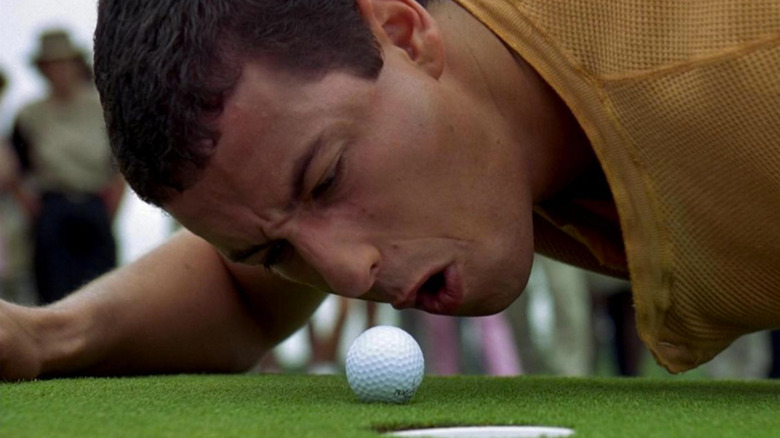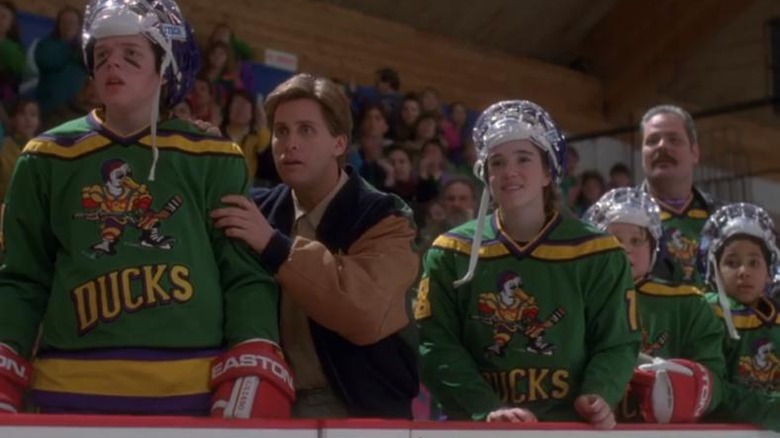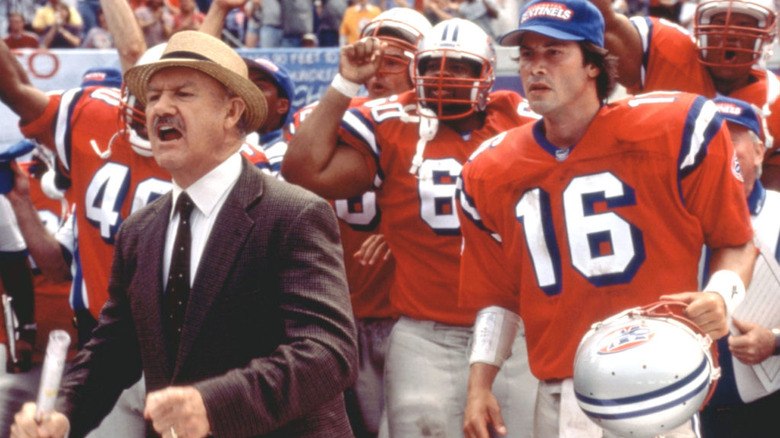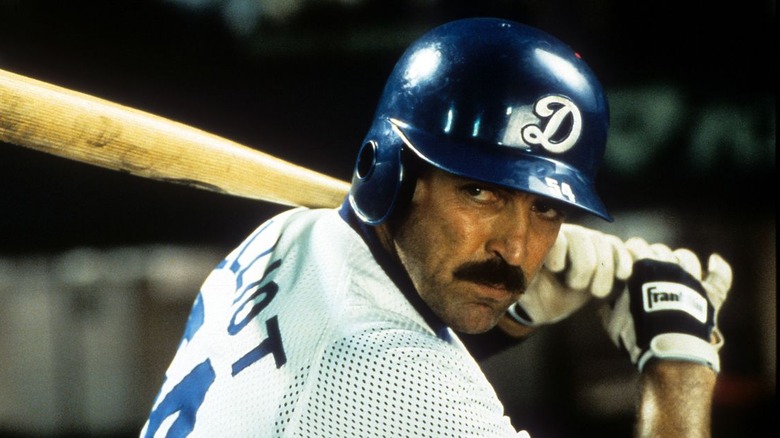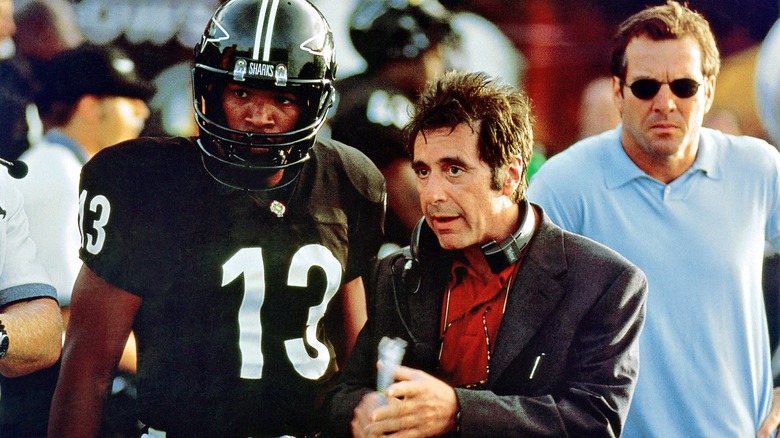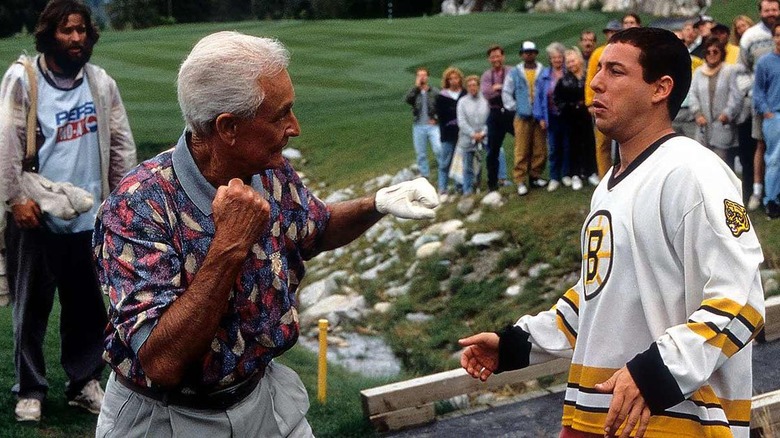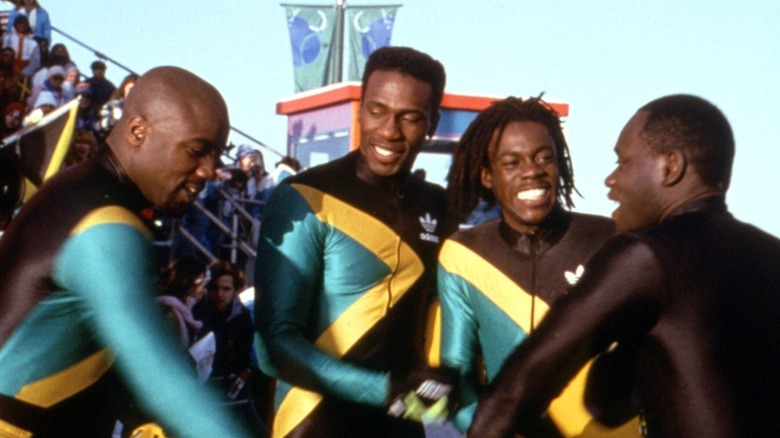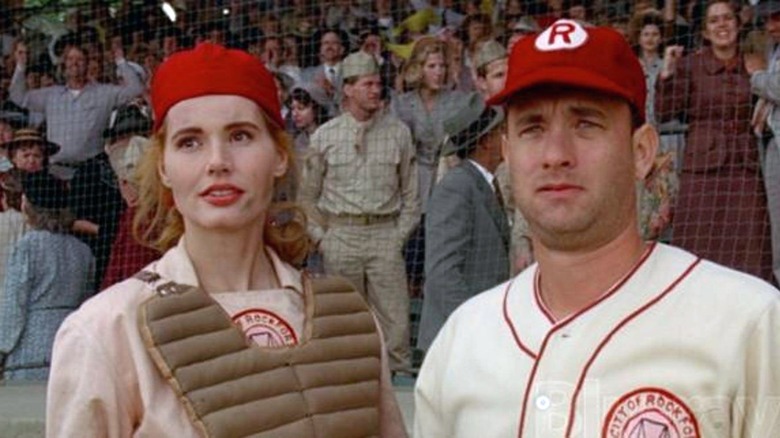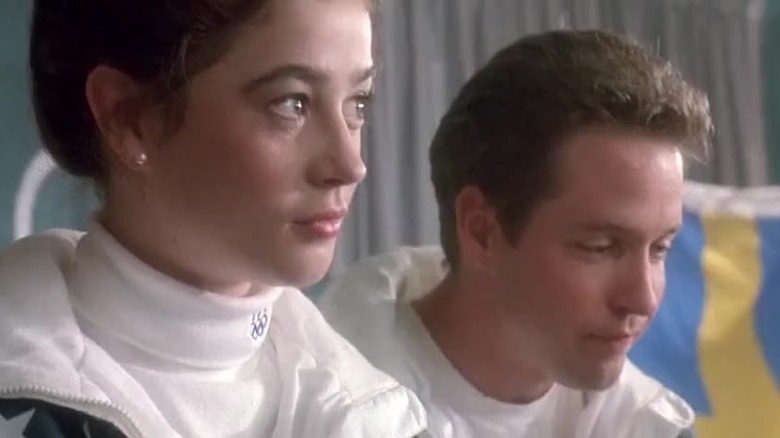Sports Movies That Get Sports Wrong
Sports movies exist within an interesting space in the entertainment world. While most moviegoers don't put a high price on realism, courtesy of the suspension of disbelief, sports movies can bring out any sports fan's inner nit-picker to find a fundamental flaw in even the most inane offering. A lot of films barely respect the laws of physics and some show little respect even for their prospective audiences, but we expect them to respect our favorite sports, whether they're fictional sports comedies simply using a sport as a vehicle for laughs or documentaries and dramas based on true events. And for that reason, these competing values of accuracy and entertainment make sports movies fertile grounds for cognitive dissonance.
The argument could be made that pointing out problems in even the best sports comedies is like shooting fish in a barrel and that would be correct. It's why we're not going to talk about the hidden ball trick in "Rookie of the Year" resulting in a balk when Henry Rowengartner (Thomas Ian Nicholas) steps on the mound without the ball in his hand. We're not going to mention that the Jamaican bobsled team didn't actually carry their sleigh on their shoulders after crashing because it's for dramatic effect and doesn't represent a fundamental flaw in our understanding of the sport. There's a difference between small inaccuracies or writing for effect and straight up getting something wrong, but we're sure opinions vary on some of these. Here are the sports movies that get sports wrong.
The Mighty Ducks movies have plenty of errors to quack about
The first "Mighty Ducks" movie may have served as an introduction to the sport of hockey for a lot of Generation Y when it premiered in 1992, but it also presented plenty of misconceptions at the same time. First and foremost, that level of body checking doesn't really exist in pee wee ice hockey, so you wouldn't see a lot of the dramatic, double-team collisions into the boards shown in the film at a youth hockey game. In fact, the sport's governing body, USA Hockey, banned body checking in 2011 for age groups 12 and under as a safety measure to help prevent injuries. Obviously that rule change came nine years after the film premiered, but the lack of realism remains.
Been working on your triple deke? That's commonly referred to as stick handling and there's not really anything special about it, despite the fancy name the films give Coach Gordon Bombay's signature move.
The big mistake of the "Mighty Ducks" franchise is the Flying V is a mess of interference penalties. Skating in a formation like that might look cool, but not only would opposing players skate forward to attack the puck, attempting to provide "a protective screen and limiting the opportunity for an opposing player to apply pressure to a teammate in possession and control of the puck" is one of USA Hockey's definitions of interference. When the Ducks cross the blue line into the attacking zone, four of the five skaters peel off to engage Hawks players physically, more interference, as players not in control or possession of the puck cannot initiate contact to prevent defenders from playing the puck.
The Replacements should have called a substitution on this play
Sure, like with "The Mighty Ducks," criticizing the accuracy of sports comedies might be low-hanging fruit, but there are some important points of contention when it comes to the underrated 2000 Keanu Reeves football gem, "The Replacements." It's a great sports comedy and tons of fun, but two sequences written just for the laughter are laughably inaccurate.
In the final game, after Shane Falco (Reeves) returns to the Washington Sentinels during halftime, he calls a "Kickass on one" for their first play from scrimmage. No, that's not an actual football play; it's basically every player's cue to assault the opposing team and it's really funny. But then the referee calls multiple unnecessary roughness calls on the play, struggles to do the math, and asks for help on how many yards the Sentinels should be penalized. The problem is those penalties don't stack; according to the NFL's Rule 14, Section 1, Article 3, only one foul can be enforced, even on plays in which multiple flags are thrown.
Another issue is Falco's use on special teams. We get it, the team is thin when it comes to manpower. But you're going to use pretty much any other available warm body to hold the ball for the kicker before your starting quarterback. Sure, it works for Nigel Gruff (Rhys Ifans) blowing that field goal kick and Falco taking a shot at the end zone in the last game, but he'd never be on the field for a kickoff, so he couldn't be the one to tackle Danny Bateman (Jon Favreau) when he recovers the onside kick in the second game.
Mr. Baseball definitely ran outside the base lines
Baseball has certainly changed a lot over the years as technology has advanced. Managers now use advanced statistical analysis and spray charts to employ defensive shifts based on a hitter's tendencies. But some things will not change, and those are the things the filmmakers got wrong in Tom Selleck's "Mr. Baseball." Selleck's character, Jack Elliot, plays in a Japanese baseball league and makes it clear he doesn't get paid to bunt. But, for some strange reason, he expects to do exactly that in a critical moment with the bases loaded and two outs with his team down 6-5. His manager Uchiyama (Ken Takakura) signals for him to swing away, despite the fact that a home run would break his own record of seven consecutive games with a homer and infuriate the team's owners, who don't want an American breaking the record. Elliot calls time to confirm the call and then proceeds to lay down a bunt, driving in a run.
Elliot calling time to confirm with his manager was a great bit of filmmaking that mirrors the sequence in which he delivered the line about not bunting and establishes emotional stakes. The problem is bunting only makes sense with just a single out to sacrifice in a run. With two outs, if Elliot missed the pitch entirely or fouled the pitch off, it would result in a strikeout and the game would be over. That's ignoring the fact that Elliot should have been called out for interference when he flagrantly veered off the base path to knock down the fielder trying to tag him out at first base.
You can win, lose, or make mistakes on Any Given Sunday
In 1999, audiences saw acclaimed director Oliver Stone apply his particular brand of filmmaking to professional football for "Any Given Sunday," which was based on the novel of the same name by former NFL defensive end Pat Toomay. It featured plenty of hard hits, hard partying, and hard life lessons. Some of those hits provided major drama but also major potential for optic nerve injury based on how hard viewers must have rolled their eyes — probably not the eyeball reference you were expecting. Quarterback Willie Beamen's (Jamie Foxx) first play from scrimmage is a perfect example. While the teams are part of an imaginary football league that is certainly not the NFL — likely owing to legal concerns — there's a zero percent chance the late hit Beamen takes at the end of the run goes unpenalized. The ball was clearly away and the hit took place after the runner was downed, which at least would have resulted in a dead-ball foul for unnecessary roughness but likely would have seen the defender ejected.
There's a commonly held idea that Coach Tony D'Amato's (Al Pacino) first locker room speech has a fundamental football blunder as well, but this is simply a matter of context. While some fans have pointed out that he's addressing the offense while noting how much they worked the blitz package during the week, he's not suggesting his offensive line blitz, which is a defensive maneuver. Instead, he's bemoaning his O-line's inability to recognize and pick up the blitzes of the opposing team.
Happy Gilmore would not have golf purists very pleased
Golf fans might not being doing the bull dance or feeling the flow after watching the Adam Sandler comedy "Happy Gilmore." While the film features plenty of laughs, memorable lines — "You eat pieces of s*** for breakfast?" — and some fun cameos, two very important sequences play very loose with the actual rules of golf.
Play it as it lies, the bane of Shooter McGavin's (Christopher McDonald) existence. While the spirit of the rule is central to the sport of golf as a whole, it certainly wouldn't apply to a player's ball landing on someone's shoe, ignoring the impossible physics of the ball actually coming to rest on Mr. Larson's (Richard Kiel) work boot. The concept is rendered moot because McGavin's shot went out of bounds; he'd take a one-stroke penalty and either be forced to drop or tee off again.
The concept comes back up on the final green. The damaged TV tower — struck by McGavin's crazed fan Donald (Joe Flaherty) with a Volkswagen Beetle — would be considered an "abnormal course condition" called an immovable obstruction once it fell onto the green and the issue really has nothing to do with how the ball lies. Under the United States Golf Association's Rule 16, Happy Gimlore (Adam Sandler) would have been able to place his ball at the "nearest point of complete relief" from the interference without a stroke penalty. Obviously the result was a lot cooler.
A hot take on Cool Runnings
Feel the Rhythm! Feel the Rhyme! Get on up, it's fast-and-loose time with "Cool Runnings!" While the sports comedy loosely based on the real-life Jamaican bobsled team's introduction at the 1988 Winter Olympics is a lot of fun, it's got some pretty clear issues with accuracy when it comes to the gravity of the subject matter. After all the antics and team-building and overcoming coach Herb Blitzen's past misdeeds, the Jamaicans have earned the right to represent their country on the international stage; there's just a huge problem with how it's shown. In one sequence showing the opening ceremony, the movie cuts to a shot of the Olympic Flame blazing in all its glory while showing the Jamaican team entering the Olympic Stadium. But the flame was not lit in Calgary until after every team had assembled, as it always is. It's a major faux pas in the tradition and pageantry central to the Olympic games.
Aside from erring on the thematic side of things, the film's depiction of the actual competition is flawed as well. As per the official Olympics website, the four-man bobsleigh event consists of four runs, typically over two days. As it's shown in "Cool Runnings," three runs over the course of three days is not how the sport is played. While it is true that the Jamaican team crashed in their third run, it was not their final scheduled run and it didn't come during a third day of competition.
Things to bemoan in A League of Their Own
The first and most important thing "A League of Their Own" gets wrong about the sport of baseball is that there absolutely is crying in baseball. OK, maybe thats not too important. But some of the charming sports comedy's moments are fundamentally inaccurate. First, though it makes for a great movie moment when center fielder Mae Mordabito (Madonna) doffs her cap and catches the ball in it for an out, it wouldn't actually have been an out. Baseball rules state a ball must be caught with the glove or hand and players cannot use any other part of their uniforms to trap the ball.
Another point of contention is the pitching. In the early days of the All-American Girls Professional Baseball League, pitchers were required to throw underhand, more akin to fast-pitch softball. But pitchers like Kit Keller (Lori Petty) are seen throwing overhand throughout the film.
Speaking of Kit, anyone wonder if she's a pull hitter? Think about the spray charts we mentioned earlier; pull hitters typically place the ball in the same side of the field as the one they bat from. Kit's sister Dottie Hinson (Geena Davis) tells her there's a hole in right field and says she'll have to pull the ball if she sees an inside pitch. There's just one problem: Kit bats right-handed, which puts her on the left side of home plate in the batters box. Kit would pull the ball to left field; placing it in right field would require her to go opposite field and would probably come on a pitch outside.
The Cutting Edge goes for drama
The cutting edge isn't just the place to be when it comes to technology and art, it's also a romantic sports comedy starring D.B. Sweeney and Moira Kelly as Olympic figure skaters Doug Dorsey and Kate Moseley. At least they end up as a figure skating pair; when they meet cute by running into each other at the film's onset, Dorsey is actually the captain of the United States men's ice hockey team. But the head injury he sustains costs him a shot at the NHL due to its permanent effect on his peripheral vision. And maybe that wasn't the only head injury involved in the film, considering some of the movie's goofs — and we're not even going to mention the sheer physical impossibility of the pair's specialty move, the Pamchenko.
While the darkened rink and bright spotlight make for dramatic movie scenes, they're not used in competitive figure skating, as The Atlantic reported. Specialty lighting simply isn't used in competition and the judges would not be able to properly assess how well a given pair makes use of the ice if the arena was dimmed.
Another logistical issue that would have saved a lot of trouble: Dorsey and Moseley would not have been allowed to debut as a pair at Nationals. In order to appear at Nationals, they would have needed to have placed at a Regionals event and performed at qualifying events for that competition year. You can't just show up at the second biggest stage in a sport's competitive hierarchy and expect to be allowed to compete; what do you think this is, a movie?
